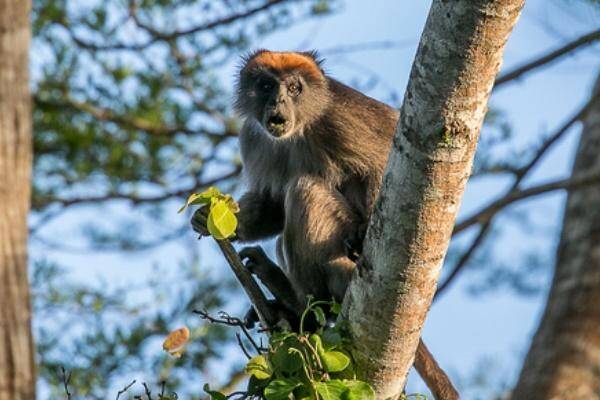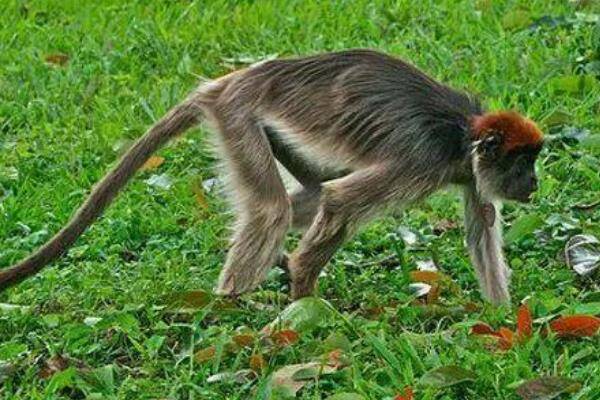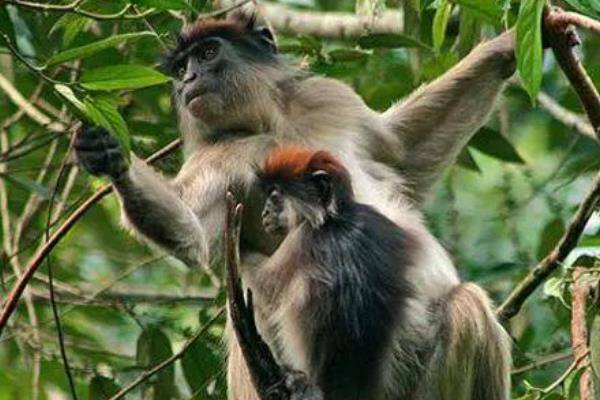Piliocolobus rufomitratus
IUCN
LCBasic Information
Scientific classification
- name:Piliocolobus rufomitratus
- Scientific Name:Piliocolobus rufomitratus,Eastern Red Colobus,Eastern red colobus, Tana colobus
- Outline:Primates
- Family:Cercopithecidae R.Colobus
Vital signs
- length:47-63cm
- Weight:5-11kg
- lifetime:No verification information
Feature
One of the world's 25 most endangered primates
Distribution and Habitat
Kenya.
Inhabits evergreen riverine forests that are periodically flooded by the Tana River. These isolated forest clusters are subject to groundwater fluctuations, river course changes, and human disturbance, creating a very fragmented and unstable habitat. This riverine forest habitat has an average annual precipitation of 470 mm and temperatures between 21.4-33°C. In contrast to the habitats of other red colobus species in East and Central Africa, this habitat is more arid and has a lower density and diversity of trees. In general, the canopy of the Tana River forests is more open than in the habitats of other red colobus species.
Appearance
The Tana River Red Colobus is 47-63 cm long, with a tail length of 52-80 cm and a weight of 5-11 kg. The hair on the top of the head, back, outer upper wrist, forehead, outer thigh, tail and other parts is gray to dark black; the back and sides of the body are reddish black, and the chest, limbs and inner side of the head are reddish brown. The pubic area is white; the hair on other parts is light orange to orange-red. The tail is gray and quite long. This species has several characteristics that adapt to an arboreal lifestyle, including slender arms and a degenerate thumb tubercle, which is common in all colobus monkeys. The thumb has degenerated into a small wart, so it is called a colobus monkey. The cheek pouches are smaller than those of ordinary monkeys. The hind limbs are particularly long and well-developed, allowing them to pass through the tree canopy, which is the same as other red colobus monkeys. Their average weight is estimated to reach 5.8 kg, similar to the Zanzibar re
Details
Tana River Red Colobus (scientific name: Piliocolobus rufomitratus) is called Eastern Red Colobus in foreign language, and has no subspecies.

Tana River Red Colobus has a smaller family territory than other red colobus monkeys. The average family range is close to 9 hectares, with an average of 34-114 hectares per hectare. The average length is 603 meters. They live in the upper and middle layers of the forest and rarely come to the ground. The family consists of an average of 8-15 members, usually including an adult male, several females and their young. Several females will raise the young monkeys in the family together, and males will leave the family before they reach adulthood, while females will remain in the family.
Like many primates, Tana River red colobus monkeys often participate in social behaviors such as play, aggression and intimidation. Contests can be anything from chasing and wrestling to jumping branches. Aggressive behaviors can be minor, such as grimacing, touching or slapping. These are often associated with various body and limb postures. Major agitated behaviors usually include staring and glaring, often accompanied by slapping or shaking branches, and in extreme cases, physical violence. These aggressive behaviors often occur between males and are related to dominance and group status. In general, males attack each other more frequently than females, although the full impact of this behavior has not yet been examined for the small number of males in the Tana River red colobus species.
The Tana River red colobus is a noisy, social animal that lives in heterosexual groups. Typically, red colobus live in groups of 30-50 members, including multiple males and females. However, in the reduced and fragmented habitat of the Tana River, the number of individuals in each group is much smaller, ranging from 12-30 individuals. In stark contrast to the rainforest species, the Tana River red colobus usually has only 1-2 males. These population statistics allow males greater access to mates and indirectly reduce pressure on the limited resources of their fragmented habitat. The causes and effects of the Tana River's small and fragmented habitat on the red colobus' behavior are still under investigation, but the differences between the Tana River red colobus group size, low males, and rainforest species are very clear.

The daily food budget of Tana River red colobus monkeys is quite different from that of rainforest species. They spend most of their time resting (47.8%) or eating (30.0%) on average, and the rest of their time moving (7.2%), grooming (4.1%) or playing (3.4%). Feeding usually occurs in the early morning or late evening. Inactivity is common during midday and late evening. Although the Tana River Red Colobus is mainly active during the day, observations of other Red Colobus species indicate that some calling and sexual activity occurs at night. The Tana River Red Colobus is a herbivorous species, which is related to the morphological adaptations for this diet. All Red Colobus monkeys differ from other Old World primates in that they have a ruminant stomach rather than a simple stomach. This stomach consists of a large sac cavity, which is divided into four chambers like herbivores in order to digest crude fiber, and has a rumination function. One of the proventriculus has an alkali/acid system designed to digest plant matter using bacterial fermentation. These primates also have high pointed ridged molars that are used for shearing and folding leaves and seeds. This helps to break down the cell walls and extract the nutrients contained therein. The main diet is the shoots, leaves and stems of plants, the fruits of leguminous plants, but also fungi, wild fruits and cereals, including fruits and flowers. In a study of dietary choices, the Tana River Red Colobus ate not only young leaves (36%), but also fruits and seeds (25%, mostly immature), leaf buds (16.4%), mature leaves (11.5%), and flowers (6.2%). The top three plants eaten were the fig tree (29.4%), the plant garden Sorindeia obtusifoliolata of the Anacardiaceae family (19.6%), and acacia (15.0%). These species contribute to the majority of the diet of the Tana River Red Colobus.
They can mate and reproduce all year round, and the marriage is polygamous. During the estrus period, the female monkey's genitals swell, and this behavior is told by the female to the male that it is ready to mate. The gestation period is about five months, and each litter has one cub. Generally speaking, red colobus monkeys breed throughout the year. The estimated gestation period is 4.5-5.5 months, and the interval period is 26 months. Weaning occurs before the baby is 20 months old, as continued nursing may inhibit the conception of another offspring. At birth, the skin of the baby monkey's back is black and the lower abdomen is gray. The muzzle, ears and palms of the baby monkeys of 3-4 weeks old are pink. The fur remains gray until 2-2.5 months old, starting with the head, the crest turns red. After birth, the baby monkey clings to the mother's abdomen and remains dependent on it. Generally, the baby monkey always remains very close to the mother until 2-3.5 months old, at which time the distance is about 1 meter. At 3.5-5.5 months, it will play with other monkeys. At 18 months old, the young females of the group will move to another group and may continue to move from one group to another throughout their lives. The female membership in the group is very unstable. Some males may leave the group during adolescence, but are difficult to be accepted by another group in this patriarchal social structure.

Usually only mothers care for and carry infants, and alienation to other females (non-mother care of infants) is not a common behavior. This is likely because the paternal distribution pattern of females moving out of their natal groups leads to low relatedness between females in the same group. Unrelated, unrelated females are less likely to allow other females to care for their infants. This is different from the pattern seen in baboons, where females are more closely related to each other. Males contribute little to offspring, except for territorial protection from predation and resource allocation. There does not appear to be any relationship between female dominance hierarchies and infants in the group. However, higher mortality rates have been reported following changes and turnover of male members of the group. It has been proposed that this is due to new males killing infants to remove offspring from unrelated males and bring females into estrus more quickly. Although infanticide has been observed in Tana River red colobus monkeys and other primates, the causal relationship between infanticide and its relationship to reproduction and genealogy has not been fully determined.
The Tana River red colobus monkey is one of the 25 most endangered primates in the world. They and the Tana River long-tailed monkey were the reason for the establishment of a protected area in Tana River in 1978, but they are still harassed by humans in the area. In the rainforest where the red colobus monkeys live, predation pressure from chimpanzees is high. The Tana River red colobus monkeys warn and fight predators by shouting loudly and shaking branches. However, human destruction of its habitat, habitat fragmentation, and the meat trade for jungle red colobus monkeys are more destructive to the species. The reduction in forest area and changes in the surrounding environment have had an adverse impact on the number of species. The census found that the species population decreased by 80% between 1975 and 1985, mainly due to the loss of these habitats. Conservation efforts should focus on maintaining the integrity of inland forests and reducing fragmentation.
Listed in the "IUCN Red List of Threatened Species" 2016 ver 3.1 - Endangered (EN).
Protect wildlife and eliminate bushmeat.
Maintaining ecological balance is everyone's responsibility!








